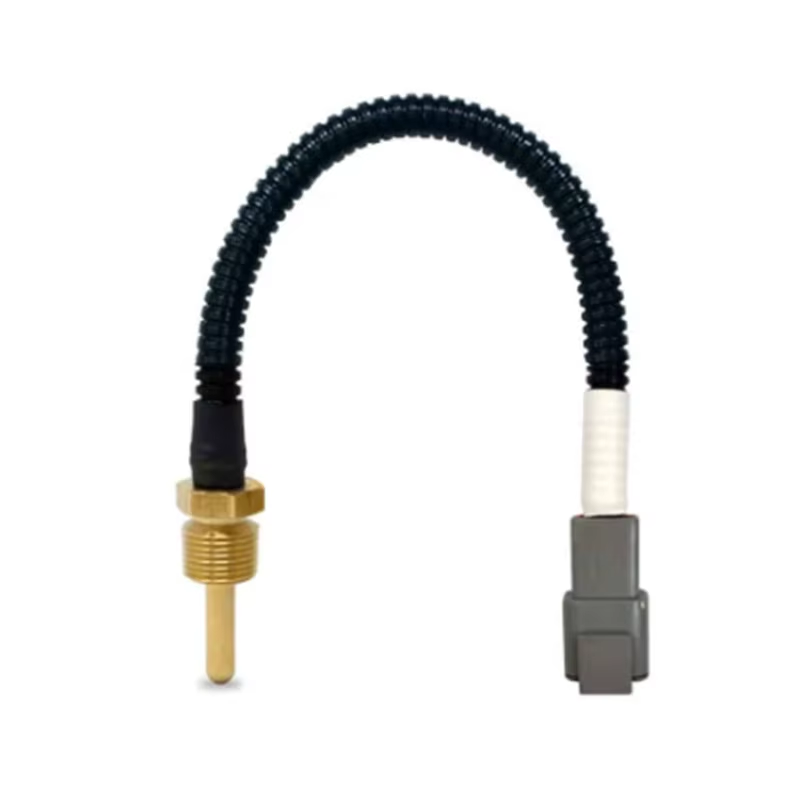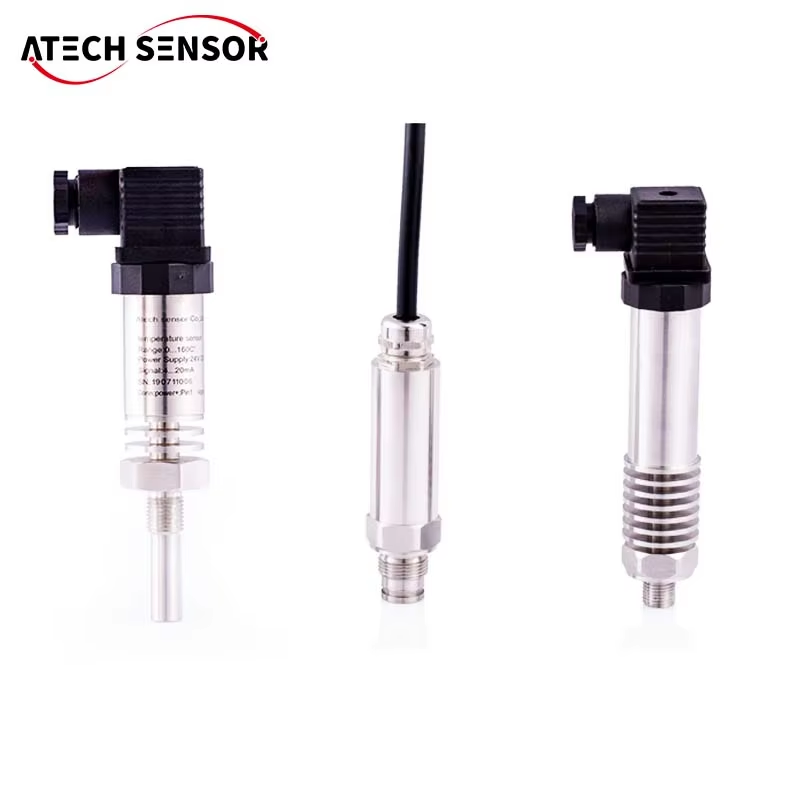Temperature sensor is a sensor that can feel the temperature and convert it into a usable output signal.Temperature sensor is the core part of the temperature measurement instrumentation, a variety of varieties.According to the measurement method can be divided into two categories of contact and non-contact, according to the sensor material and electronic component characteristics are divided into two categories of RTDs and thermocouples.
Major category
Contact
The detecting part of a contact temperature sensor is in good contact with the object to be measured, also known as a thermometer.
Thermometers achieve thermal equilibrium by conduction or convection so that the indicated value of the thermometer directly represents the temperature of the object to be measured.Generally the measurement accuracy is high.Within a certain temperature measurement range, the thermometer can also measure the temperature distribution inside the object.However, for moving bodies, small targets or objects with small heat capacity will produce large measurement errors. Commonly used thermometers are bimetallic thermometers, glass liquid thermometers, pressure-type thermometers, resistance thermometers, thermistors and temperature-difference couples.They are widely used in industry, agriculture, commerce and other sectors.People also often use these thermometers in daily life.With the wide application of cryogenic technology in the sectors of defense engineering, space technology, metallurgy, electronics, food, medicine and petrochemicals and the research of superconductivity technology, cryogenic thermometers for measuring temperatures below 120K have been developed, such as cryogenic gas thermometers, vapor pressure thermometers, acoustic thermometers, paramagnetic salt thermometers, quantum thermometers, cryogenic RTDs, and cryogenic temperature-difference thermocouples.Low-temperature thermometers require small size of the sensing element, high accuracy, reproducibility and stability.The use of porous high silica glass carburization sintered carburized glass RTD is a low-temperature thermometer is a temperature sensing element, can be used to measure the temperature within the range of 1.6 ~ 300K.
Non-contact
Its sensitive element and the measured object do not contact each other, also known as non-contact temperature measurement instrument.This instrument can be used to measure the surface temperature of moving objects, small targets and objects with small heat capacity or rapid temperature change (transient), and can also be used to measure the temperature distribution of the temperature field.
The most commonly used non-contact thermometers are based on the fundamental law of blackbody radiation and are called radiometric thermometers.Radiometric thermometry includes the luminosity method (see optical pyrometer), the radiation method (see radiation pyrometer) and the colorimetric method (see colorimetric thermometer).Each type of radiometric thermometry can only measure the corresponding photometric, radiometric or colorimetric temperature.Only the temperature measured for a blackbody (an object that absorbs all radiation and does not reflect light) is the true temperature.To determine the true temperature of an object, the surface emissivity of the material must be corrected.The surface emissivity of the material depends not only on the temperature and wavelength, but also with the surface state, coating film and microstructure, etc., so it is difficult to measure accurately.In automated production often need to use radiation thermometry to measure or control the surface temperature of certain objects, such as metallurgy in the steel strip rolling temperature, roll temperature, forging temperature and a variety of molten metal in the smelting furnace or crucible temperature.In these specific cases, the measurement of the surface emissivity of the object is quite difficult.For automatic measurement and control of the temperature of solid surfaces, it is possible to use additional mirrors to form a blackbody cavity together with the measured surface.The effect of additional radiation can increase the effective radiation and effective emission coefficient of the measured surface.Using the effective emission coefficient, the measured temperature is corrected accordingly by the instrument, and the true temperature of the measured surface is finally obtained.The most typical additional reflector is the hemispherical reflector.The diffuse radiation from the measured surface near the center of the sphere can be reflected back to the surface by the hemispherical mirror to form additional radiation, thus increasing the effective emission coefficient where ε is the surface emissivity of the material and ρ is the reflectivity of the mirror.As for the real temperature of gas and liquid media radiation measurement, can be used to insert heat-resistant material tube to a certain depth to form a black body cavity method.The effective emission coefficient of the cylindrical cavity in thermal equilibrium with the medium is calculated.In the automatic measurement and control can be used to measure the bottom temperature of the cavity (i.e., the medium temperature) to correct the true temperature of the medium.
Advantage of non-contact temperature measurement: The upper limit of measurement is not limited by the degree of temperature resistance of the sensing element, so there is in principle no limit to the maximum measurable temperature.For high temperatures above 1800 ℃, the main non-contact temperature measurement methods.With the development of infrared technology, radiation temperature measurement gradually from visible light to infrared expansion, 700 ℃ up to room temperature have been used, and high resolution.

Working Principle
Sensors designed on the metal expansion principle
Metals produce a corresponding extension in response to changes in ambient temperature, so sensors can signal this response in different ways.
Bimetal Sensors
A bimetal consists of two pieces of metal with different coefficients of expansion pasted together. As the temperature changes, material A expands more than the other metal, causing the metal piece to bend.The curvature of the bend can be converted into an output signal.
Bimetallic rod and tube sensors
As the temperature increases, the length of the metal tube (material A) increases, while the length of the non-expanding steel rod (metal B) does not, so that the linear expansion of the metal tube can be transmitted due to the change in position.In turn, this linear expansion can be converted into an output signal.
Sensors designed for deformation curves of liquids and gases
Liquids and gases likewise produce a corresponding change in volume when the temperature changes.
Various types of structures can convert this change in expansion into a change in position, which produces a change in position output (potentiometers, induced deviations, flow stops, etc.).
Resistive sensing
Metals change their resistance as their temperature changes.
For different metals, the change in resistance value is different for each degree of temperature change, and the resistance value can be used directly as an output signal.
There are two types of variations in resistance
Positive temperature coefficient
Increase in temperature = increase in resistance
Decrease in temperature = decrease in resistance
Negative temperature coefficient
Increase in temperature = decrease in resistance
Decrease in temperature = increase in resistance
Thermocouple Sensing
A thermocouple consists of two metal wires of different materials welded together at the end.The ambient temperature of the unheated part is then measured to know exactly the temperature of the heated point.It is called a thermocouple because it must have two conductors made of different materials.Thermocouples made of different materials are used in different temperature ranges and they have different sensitivities.The sensitivity of a thermocouple is the amount of change in output potential difference for a 1°C change in temperature at the heating point.For thermocouples supported by most metallic materials, this value ranges from about 5 to 40 microvolts/°C.
Since the sensitivity of thermocouple temperature sensors is independent of the thickness of the material, it is possible to make temperature sensors from very fine materials.Also due to the ductility of the metals used to make thermocouples, these fine temperature measuring elements have an extremely high response time and can measure rapidly changing processes.

Selection method
If reliable temperature measurements are to be made, it is first necessary to select the correct temperature instrument, also known as a temperature sensor.Among these, thermocouples, thermistors, platinum resistors (RTDs) and temperature ICs are the most commonly used temperature sensors for testing.
The following is a description of the characteristics of two types of temperature instruments, thermocouples and thermistors.
1、Thermocouple
Thermocouples are the most commonly used temperature sensors for temperature measurement.Its main benefits are wide temperature range and adapt to a variety of atmospheric conditions, but also sturdy, low price, no need for power supply, is also the cheapest.A thermocouple consists of two different metal wires (metal A and metal B) connected at one end. When one end of the thermocouple is heated, there is a potential difference in the thermocouple circuit.The measured potential difference can be used to calculate the temperature.
However, the relationship between voltage and temperature is nonlinear. temperature Because voltage and temperature are nonlinear, a second measurement is required for the reference temperature (Tref) and the voltage-temperature transformation is processed internally in the instrument using the test equipment software or hardware to finally obtain the thermocouple temperature (Tx). the Agilent 34970A and 34980A data collectors have built-in measurements for the arithmeticThe Agilent 34970A and 34980A data collectors both have built-in measurement.
In short, thermocouples are the simplest and most versatile temperature sensors, but thermocouples are not well suited for high-precision measurements and applications.
2、Thermistor
Thermistors are semiconductors with a mostly negative temperature coefficient, i.e. the resistance decreases as the temperature increases.Temperature change will cause a large change in resistance value, so it is the most sensitive temperature sensor.However, thermistors have extremely poor linearity and are highly dependent on the manufacturing process.Manufacturers do not give standardized thermistor curves.
Thermistors are very small and respond quickly to temperature changes.However, thermistors require the use of a current source, and their small size also makes them extremely sensitive to self-heating errors.
Thermistors measure absolute temperature on two wires, with good accuracy, but they are more expensive than thermocouples, and the range of measurable temperatures is less than that of thermocouples.A commonly used thermistor has a resistance value of 5kΩ at 25°C, with a resistance change of 200Ω per 1°C temperature change.Note that a lead resistance of 10Ω results in only a negligible 0.05°C error.It is well suited for current control applications where fast and sensitive temperature measurements are required.The small size is advantageous for applications with space requirements, but care must be taken to prevent self-heating errors.
Thermistors also have their own measuring techniques.The small size of the thermistor is an advantage, it stabilizes very quickly and does not cause thermal loads.However, it is also very unstable as a result, and high currents can cause self-heating.Since a thermistor is a resistive device, any current source will cause heating on it due to power.Power is equal to the product of current squared and resistance.Therefore use a small current source.If the thermistor is exposed to high heat, permanent damage will result.
Selection Note
1, the temperature of the object to be measured whether the need to record, alarm and automatic control, whether the need for long-distance measurement and transmission;
2, the size of the temperature measurement range and accuracy requirements;
3, the size of the temperature measurement element is appropriate;
4, in the temperature of the object to be measured over time occasions, the hysteresis of the temperature measurement element to adapt to the requirements of the measurement of the temperature;
5, the object to be measured by the environmental conditions of the temperature measurement element whether the damage;
6, the price of such as the insurance, the use of theWhether it is convenient.
Installation and use
When installing and using temperature sensors, the following should be noted to ensure the best measurement results:
1. Errors introduced by improper installation
Such as thermocouple installation location and insertion depth can not reflect the true temperature of the furnace, etc., in other words, the thermocouple should not be installed too close to the door and heating place, the insertion depth should be at least for the protection of the diameter of the tube 8 ~ 10 times; thermocouple protection casing and the wall of the intervals between the insulation material is not filled resulting in the furnace heat overflow or cold air intrusion, so the thermocouple protection tube and the furnace wall holes in the air gap between the application of refractory clay or asbestosRope and other adiabatic material plug to avoid hot and cold air convection and affect the accuracy of temperature measurement; thermocouple cold end is too close to the furnace body so that the temperature exceeds 100 ℃; thermocouple installation should be avoided as far as possible strong magnetic and electric fields, so should not be thermocouples and power cables mounted in the same conduit to avoid the introduction of interference caused by error; thermocouple can not be installed in the measured medium is rarely flow in the region, when measuring the temperature of gas by thermocouple tube, must make thermocoupleWhen using thermocouples to measure the temperature of the gas in the tube, the thermocouple must be installed against the direction of flow, and fully in contact with the gas.
2. Errors introduced by insulation deterioration
Such as thermocouple insulation, protection tubes and pull the wire plate dirt or salt slag too much to cause the thermocouple between the poles and the furnace wall insulation is poor, more serious at high temperatures, which will not only cause the loss of thermoelectric potential but also the introduction of interference, which caused by the error sometimes up to hundreds of degrees.
3. Errors introduced by thermal inertia
Due to the thermal inertia of thermocouples, the indication value of the instrument lags behind the measured temperature change, and this effect is particularly prominent when making rapid measurements.So should be used as far as possible, the heat electrode is thin, the diameter of the protection tube is small thermocouple.When the temperature measurement environment permits, the protection tube can even be removed.Due to the measurement hysteresis, the amplitude of the temperature fluctuations detected by the thermocouple is smaller than the amplitude of the furnace temperature fluctuations.The larger the measurement hysteresis, the smaller the amplitude of the thermocouple fluctuations, the greater the difference with the actual furnace temperature.When using a large time constant thermocouple temperature measurement or temperature control, the instrument shows the temperature fluctuation is very small, but the actual furnace temperature fluctuations may be very large.In order to accurately measure the temperature, a thermocouple with a small time constant should be selected.Time constant and heat transfer coefficient is inversely proportional to the diameter of the hot end of the thermocouple, the density of the material and the specific heat is proportional to the diameter of the hot end of the thermocouple, if you want to reduce the time constant, in addition to increase the heat transfer coefficient, the most effective way is to minimize the size of the hot end.In use, usually using materials with good thermal conductivity, thin wall, small inner diameter of the protective casing.In more precise temperature measurements, bare wire thermocouples without protective sleeves are used, but thermocouples are easily damaged and should be calibrated and replaced in a timely manner.
4、Thermal resistance error
At high temperature, if there is a layer of soot on the protection tube, dust attached to it, the thermal resistance increases, hindering the conduction of heat, when the temperature indication is lower than the true value of the measured temperature.Therefore, should keep the thermocouple protection tube external clean, in order to minimize the error.
main application
Temperature is a physical quantity that characterizes the degree of heat and cold of an object, and is a very important and common measurement parameter in the process of industrial and agricultural production.Temperature measurement and control to ensure product quality, improve production efficiency, energy conservation, production safety, and promote the development of national economy plays a very important role.Due to the universality of temperature measurement, the number of temperature sensors in a variety of sensors in the first place, accounting for about 50%.
Temperature sensors are used to measure indirectly by means of an object changing a certain characteristic with temperature.Many materials, components of the characteristics of the temperature change with the change, so can be used as a temperature sensor material is quite a lot.Temperature sensor with the temperature and physical parameters caused by changes in: expansion, resistance, capacitance, and electric potential, magnetic energy, frequency, optical properties and thermal noise and so on.With the development of production, new temperature sensors will continue to emerge.
Due to the extremely wide range of temperature measurement in industrial and agricultural production, from several hundred degrees below zero to several thousand degrees above zero, and temperature sensors made of various materials can only be used within a certain temperature range.
The contact between the temperature sensor and the measured medium is divided into two categories: contact and non-contact.Contact temperature sensors need to maintain thermal contact with the measured medium, so that the two are sufficient heat exchange to achieve the same temperature.This category of sensors are mainly resistive, thermocouple, PN junction temperature sensor.Non-contact temperature sensors do not need to contact with the measured medium, but through the measured medium of thermal radiation or convection to the temperature sensor, in order to achieve the purpose of temperature measurement.This category of sensors are mainly infrared temperature sensors.The main feature of this method of temperature measurement is the ability to measure the temperature of substances in motion (e.g., the bearing temperature of a slow-moving train, the temperature of a rotating cement kiln) and objects with a small heat capacity (e.g., the temperature distribution in integrated circuits).

